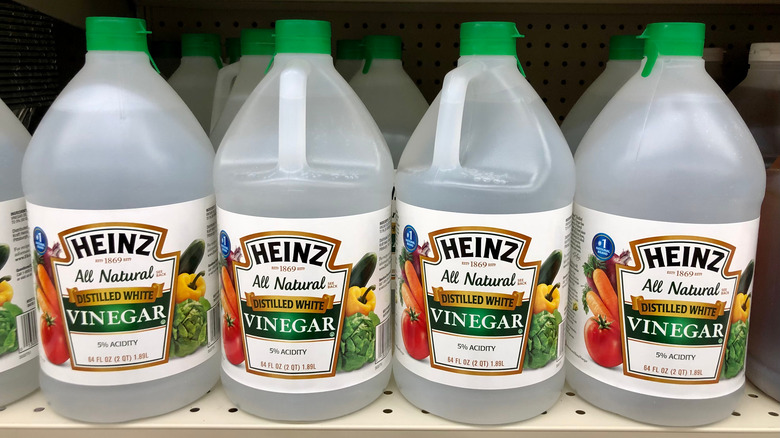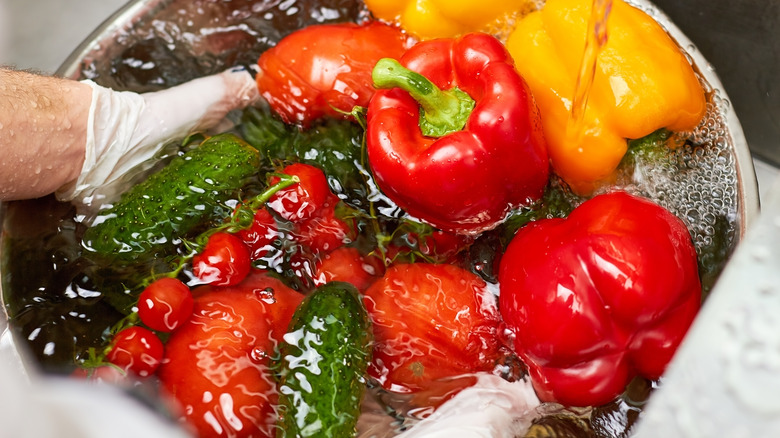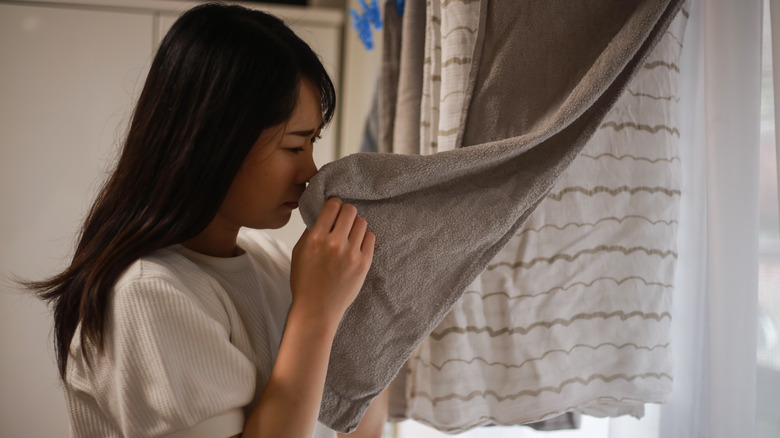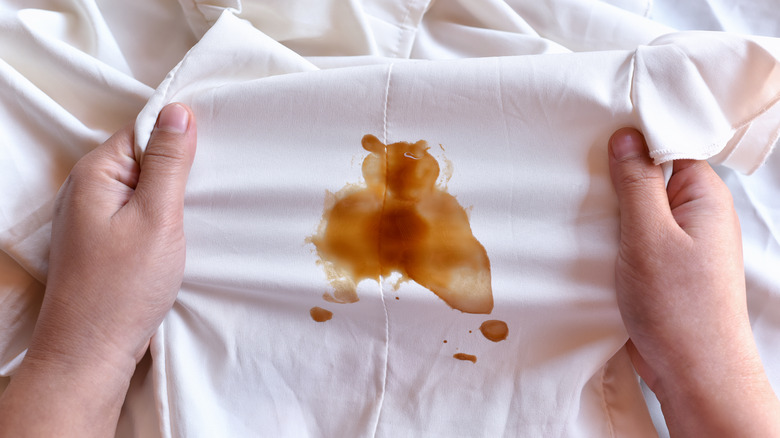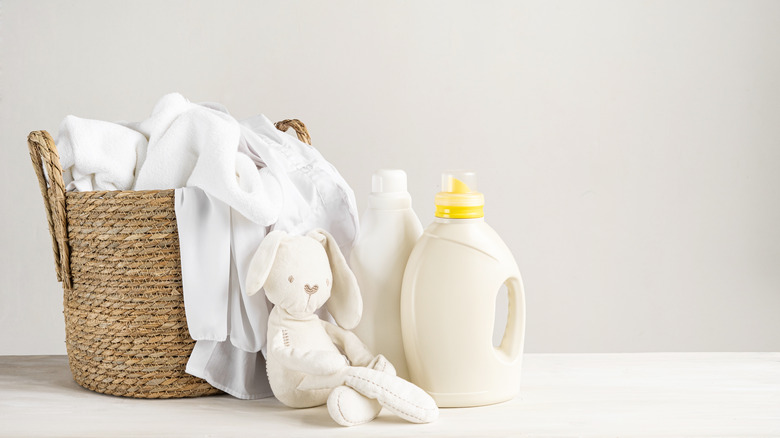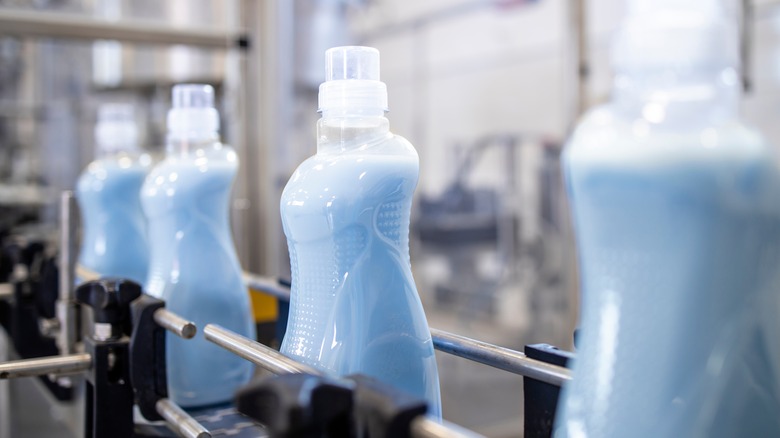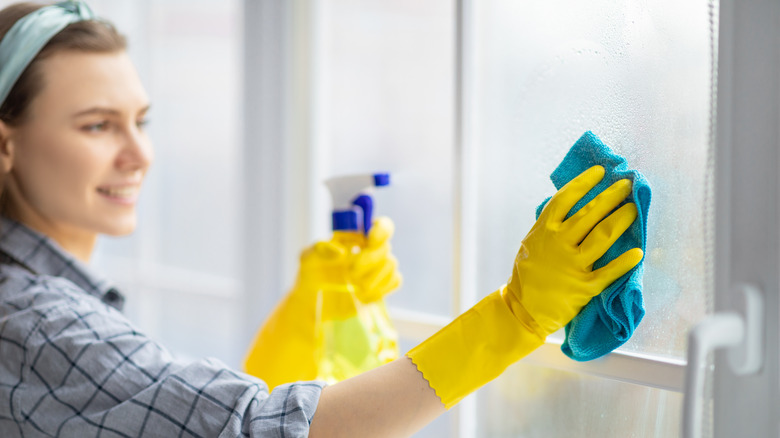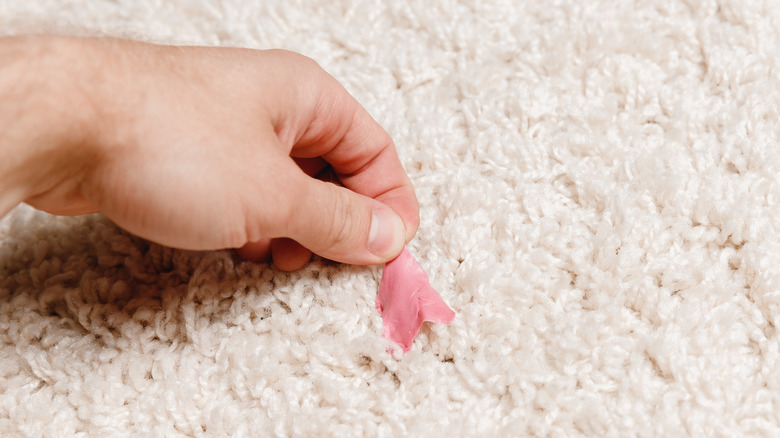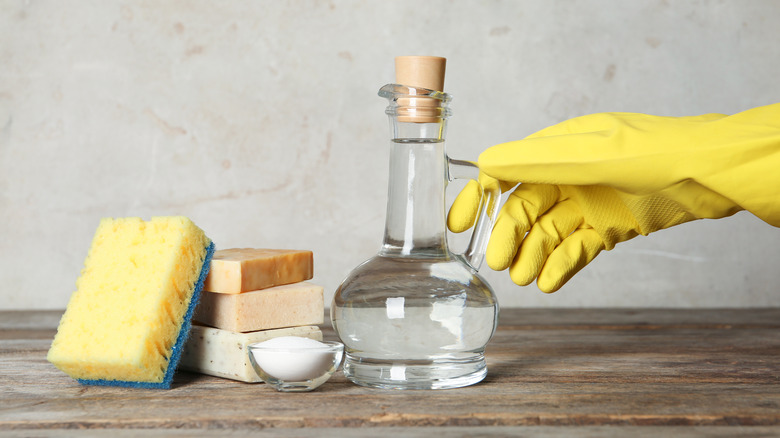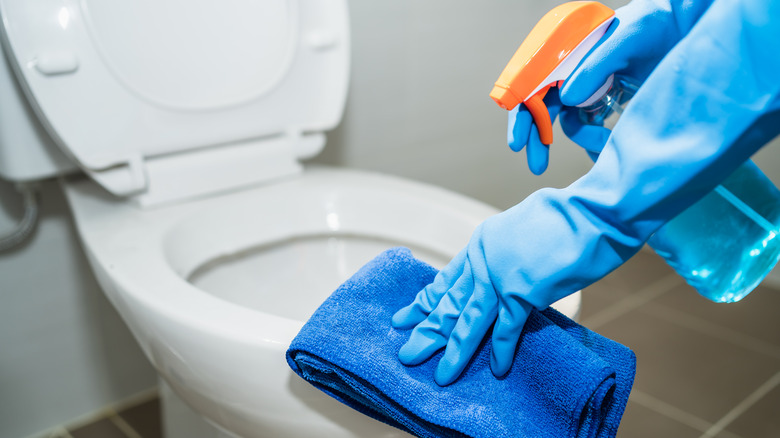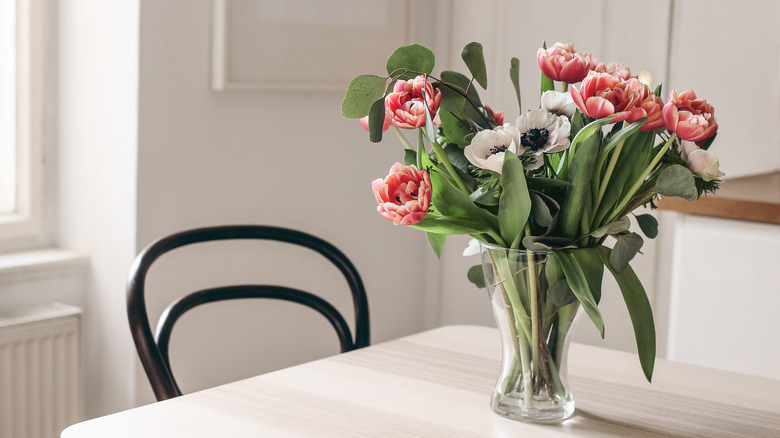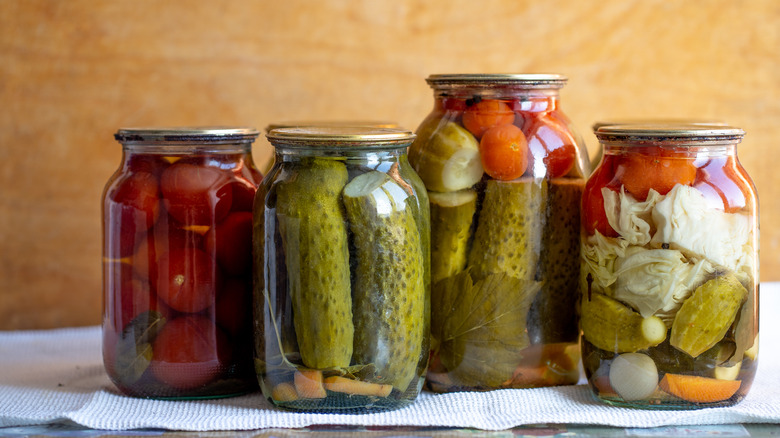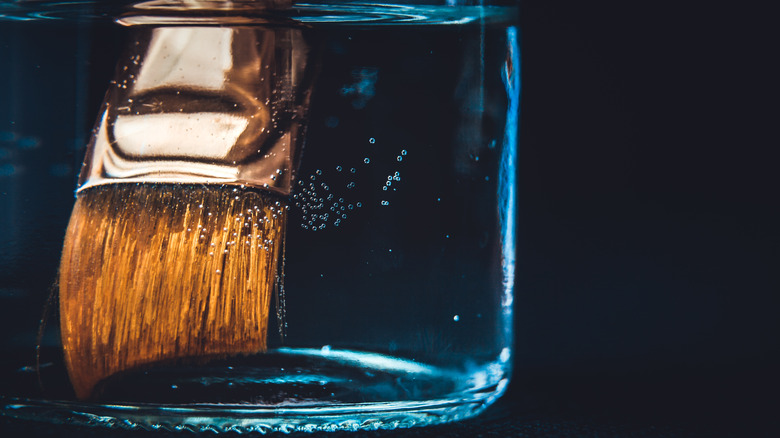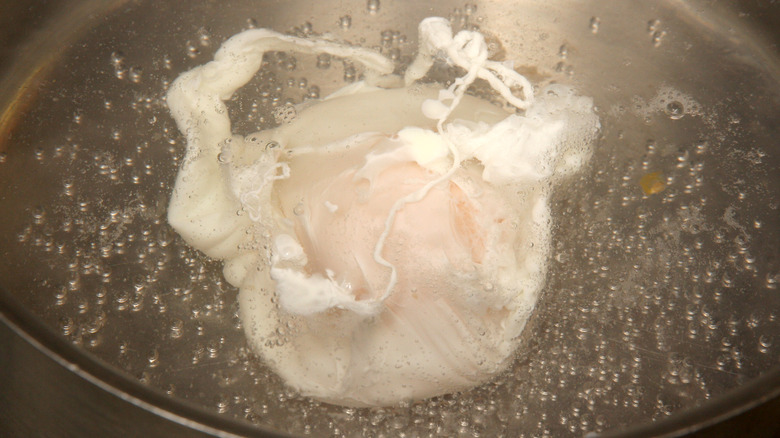13 Interesting Ways To Use Distilled White Vinegar
We may receive a commission on purchases made from links.
There's one item in your food pantry that is altogether economical, versatile to cook with, and environmentally friendly, and can clean everything from your coffee pot to your toilet to your towels. It's distilled white vinegar. Vinegar, which comes from the French word vin aigre, meaning "sour wine," uses acetic acid bacteria to convert fermented alcohol (via Almanac). There are many different types of vinegar in the supermarket, but the most multifaceted commercial vinegar product is distilled white.
Not to be confused with other infused vinegars like balsamic, red wine vinegar, or white wine vinegar, distilled white vinegar is a clear solution that has been diluted for safe consumption and use at home. Aside from adding it to salad dressings and sauces, distilled white vinegar has over 100 common household uses beyond cooking, so we decided to round up a list of the most interesting ways to use it in the hopes of saving you money, cleaning more effectively, and doing it all in the most non-toxic way possible.
Clean fruits and vegetables
Unwashed fresh fruits and vegetables may be rich in vitamins, nutrients, fiber, and minerals, but they may also contain harmful bacteria and fungi as well as trace amounts of chemicals and heavy metals from the soil or from unsafe handling of raw produce, so it's important to properly wash your produce prior to consumption (via Colorado State University and the U.S. Department of Agriculture). One effective way to remove microbes, dirt, and sand is to use a veggie wash, such as those available for purchase in the grocery store. However, it's just as effective, and will also save money, to give your fresh produce a rinse with distilled white vinegar.
In fact, according to a comparison test done by NPR, diluted white vinegar kills 98% of bacteria and proved to be the best method for scrubbing fruits and vegetables when compared to an antibacterial soap (not recommended by food safety experts), a scrub brush technique, and a straightforward rinse with water. The trick is to dilute the vinegar in three parts water and one part vinegar, and either spray the produce or soak it in a cold water solution for a couple of minutes.
Remove odors
Among its many uses, white vinegar is touted for its ability to perform almost any task in the laundry room, and that includes removing odors. According to Homes and Gardens, white vinegar is a non-toxic alternative to most laundry detergents, and it can be used as a soak or added straight into the washing machine. If you've forgotten laundry in the washer for a day or two, or perhaps you notice your towels have started to smell a bit musty, white vinegar will remove these odors in just one wash cycle or overnight soak.
In addition to removing odors from laundry, distilled white vinegar is also successful in removing the smell of gasoline from your hands. It can also be applied after chopping stinky foods like onion and fish to prevent the smells from lingering on your hands, according to the American Heart Association. Although the smell of vinegar can be quite pungent, it surprisingly does not linger on towels or other fabrics after being laundered, and it can be removed from hands quite easily with a little bit of soap.
Remove stains
Whether it's stains on your skin, in your clothes, or on your carpet, distilled white vinegar is the miracle stain remover to tackle any seemingly permanent spot of dirt, including wine, ink, coffee, grease, blood, mud, and more. For stubborn grease stains on clothes and upholstery, NBC News recommends using a solution of half vinegar and half water applied liberally and followed by a laundry-wash treatment. Pet stains, mud, and dirt in your carpet may also benefit from a distilled white vinegar saturation using the same method of one part vinegar and one part cool water. Another trick for clothing and linen stain removal is to mix equal parts distilled white vinegar with milk and give your dirty clothes a soak before washing them, which should lift stubborn spots and stains.
ThriftyFun suggests using distilled white vinegar without diluting it with water on your hands to remove food stains, like fruits, berries, and coffee. Other stubborn food stains from ketchup, barbecue sauce, and tomato sauces can be wiped clean from countertops, Tupperware, and even clothes with a diluted white vinegar solution.
Brighten whites
Hailed for its many uses when it comes to all things laundry, distilled white vinegar is an effective alternative to bleach and other harsh chemicals when added to the bleach dispenser of your washing machine (via Homes and Gardens). Before washing any garment, Martha Stewart says to first check the label for washing instructions or limitations, and then to separate all your whites from your colors. Next, flush the stain with white vinegar and dish soap before adding it to scalding hot water in the washing machine. Another method for brightening dingy socks, stained white towels, and other articles of white clothing is to soak them in boiling water and a cup of distilled white vinegar overnight.
A final tip on brightening whites is to never mix vinegar with chlorine bleach as the combo can create fumes that are unsafe for your respiratory system (via Better Homes and Gardens).
Soften fabrics
Not only are fabric softeners expensive and unnecessary (most detergents contain ingredients meant to soften clothes without the need to add fabric softener), they're also chock-full of harsh chemicals, fragrances, and known carcinogens that Martha Stewart states are harmful to sensitive skin as well as the environment. According to SF Gate, chemical fabric softeners may also leave behind a residue that may even interfere with flame retardancy on clothing.
A budget-friendly, environmentally safe, and hypoallergenic alternative, especially for households with hard water, is to use a solution of distilled white vinegar and your favorite essential oils, which can be added directly into the fabric-softener dispenser in your washing machine. After drying the load of laundry, Martha ensures there will not be any lingering smell of vinegar on the clothes. This economical substitution for expensive fabric softener also serves other purposes, including removing odors, brightening whites, and even disinfecting the washing machine all in one wash.
Clean glass
Having clean windows and mirrors means more than just a fresh-looking aesthetic. It helps filter light into your home, which helps brighten and illuminate the interior. SF Gate recommends creating an eco-sensitive, cost-effective DIY glass-cleaning solution by mixing equal parts of two simple ingredients: distilled white vinegar and water. The acidity in vinegar is an effective way to cut through grease, grime, and water stains on exterior windows without the use of harmful chemicals, per Insider.
Before you roll up your sleeves and get to glass cleaning, there are some tips and tricks to follow. First, mix the vinegar and water in a spray bottle for easy application. Spray your solution directly on a cloth or newspaper and start wiping. You may need to wipe your windows several times to remove the film residue left behind by previous commercial window and glass cleaners. For hard-to-remove grime, you may try scrubbing the window with steel wool dampened with vinegar and water. Paper towels may leave behind lint, so it's best to finish the process by polishing the glass or windows using a soft cloth towel.
Remove gum
Although chewing gum has benefits like freshening breath and relieving nausea, it can be a nuisance when it gets stuck on your shoes, carpet, or clothing. Using the tips and tricks provided by HomeSteady, you can remove stubborn gum and the stains it leaves behind in a few simple steps. First, fill a plastic food-storage bag with ice cubes, and place it on top of the gum to harden it. According to SF Gate, you'll want to avoid letting the ice cubes melt and saturate the carpet around the gum stain, so change the ice every five minutes or so, and leave on until the gum has hardened.
Once the gum is hard, you can either break it apart using a kitchen utensil, or scrap it off with the dull end of a kitchen knife. Then immediately discard the hardened gum pieces. Fill a small bowl with a half a cup of vinegar (for delicate carpets or fabric, dilute the vinegar with water) and heat the solution in the microwave until warm. Dip a toothbrush or cloth in the bowl of warm vinegar, and apply it to the remaining residue. Continue the process until you've removed the gum stain from your carpet or clothing.
Clean kitchen appliances
Of its many cleaning miracles, distilled white vinegar is an effective way to disinfect kitchen appliances like your dishwasher, washing machine, and coffee pot. Though it may seem contrary to common sense to clean an appliance that serves the purpose of cleaning and disinfecting dishes or clothes, cleaning your dishwasher and washing machine are important in maintaining their overall functionality. Per HGTV, soap residue builds up in your appliances over time, and the most effective way to remove soap scum, food stains, and bacteria is with undiluted distilled white vinegar. When cleaning the dishwasher, fill a dishwasher-safe bowl or glass with white vinegar and place it on the top rack, then run the dishwasher using hot water.
Better Homes and Gardens recommends cleaning the washing machine with distilled white vinegar in order to remove soap residue and musty odors. Pour 2 cups of vinegar in the detergent dispenser, and run the cycle on hot. You can also use vinegar to scrub the inside and outside of the washing machine to get it squeaky clean.
Lastly, clean your coffee pot by pouring equal parts water and distilled white vinegar into the water reservoir, then brew it as you would coffee (via Better Homes & Gardens). You can pause the coffee maker halfway through the cycle to allow the white vinegar to soak in the coffee maker and carafe for more thorough cleaning. Then rinse by brewing two cycles of fresh water to remove any lingering vinegar smell or taste.
Disinfect bathroom
The bathroom may be one of the more bacteria-laden areas of your home and will greatly benefit from a homemade distilled-white-vinegar disinfectant solution. According to Home Depot, your shower head needs to be cleaned periodically to remove built-up mineral deposits and hard-water debris. Plus, the humidity created by regular hot showers is a breeding ground for bacteria and mold. The best way to ensure your shower head isn't spraying you with unwanted germs is to clean your shower head regularly using distilled white vinegar. Fill a plastic food-storage bag with distilled white vinegar and place it over the shower head using tape or a twist tie to seal the bag. Let the shower head soak for eight hours or overnight, then remove the bag and run hot water through the head to filter out any remaining debris.
To clean your bathroom, fill a spray bottle with white vinegar and water, and spray it on your shower walls, in the bathroom sink, and around the toilet to brighten surfaces, remove bacteria, and eliminate odors. You may also pour vinegar directly in the toilet bowl and allow it to sit before scrubbing it crystal clean.
Keep flowers fresh
Whether you're decorating with a store-bought flower arrangement or using fresh clippings from your garden, you can prolong the life of your fresh flowers by adding vinegar and dissolved sugar to your water vase (via Gardening Know How). Vinegar helps to preserve fresh-cut flowers by increasing the acidity and lowering the pH balance, and it may also help eliminate harmful bacteria that speeds up the flower's decline.
Per SF Gate, when vinegar is mixed in with sugar and water, it will help prolong the longevity of cut flowers by feeding the plant and blooming unopened buds. While ratios may vary depending on the size of the vase and the amount of flowers, most experts recommend 2 tablespoons each of vinegar and sugar for every 1-quart vase. The most important tip is not to overdo it with the sugar and vinegar, as too much of a good thing can backfire and possibly end up killing the flowers faster, so be sure to measure out the ingredients.
Pickle vegetables and fruits
White vinegar has been tapped as a food preservative for thousands of years, and pickled foods have only grown in popularity since then. One of the most simple processes of preserving food, vinegar-based pickling uses a combination of vinegar, water, salt, and your fruit or vegetable of choice to be pickled (via Food & Wine). Distilled white vinegar and white-wine vinegar are the most frequently used vinegars for pickling as they do not alter the color of the vegetables and the level of acidity.
According to the University of Minnesota, the most important factor in selecting your vinegar base is to determine the percentage of acidity, which should be clearly labeled. The key is to use vinegar with 5% acidity. To achieve the best result, all you need to do is boil the vinegar, salt, and water solution, pour it over your vegetable, leave it on the counter to cool, and then store it in a sealed container in the refrigerator.
Clean paint brushes
Whether you're a professional painter or acrylic artist, you'll want to invest in high-quality paint brushes to achieve the best outcome for your work, and the best way to prolong the life of your paint brushes is to clean them using a combination of cool water and distilled white vinegar, according to Art and Drawing. Paint brushes are typically very delicate, and the bristles need to be handled with care, which is why waiting until the paint has dried before cleaning them is not recommended.
Instead, you'll want to fill a small bowl with water and a few drops of vinegar, then swirl your paint brush around in the solution and rinse it until the water is clear. If there is dried paint on your paint brush, you may give it a soak in vinegar and water until the paint softens and peels away. Using harsh chemicals or detergents can further damage your paint brush and alter the way it shows up on painted canvas or surface, so white vinegar is the most advantageous cleaning option.
Poach eggs
Poaching eggs is a seemingly simple cooking technique, but it requires certain steps that make it difficult to master. In general, a poached egg is most often used in eggs Benedict recipes. It is defined as an egg that has been cooked outside the shell in water that's just below a boil. One technique involves stirring the water in a circular motion before dropping in the egg to help the egg white wrap around the yolk.
Per Victoria University of Wellington, in order to successfully poach the egg, you'll need to add distilled white vinegar to the water. The acidity in vinegar helps to speed up the poaching process by preventing the egg white from dispersing in the steaming water and becoming a liquid foam. The acidity in the vinegar acts as a solidifier with the protein in the egg whites, and it is as important in the poaching process as the temperature of the water and the time you cook the egg.
